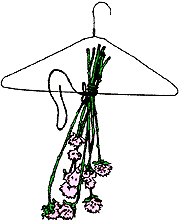Drying Flowers
Drying flowers is a great way to continue enjoying your flowers for a long time after a live arrangement would have wilted and died. Some of the best flowers to dry are: strawflower, celosia, and calendula, but you can also dry tall grasses, reeds, and cattails.
Air Drying Method

- Pick your plant material in mid-morning. Choose flowers that are just beginning to open and remove leaves from the stem.
- Use an elastic band to tie small bunches together at the end of the stems.
- Tie the end of each bundle with string to a coat hanger or peg.
- Hang them up in an airy place away from direct sunlight, which will prevent their colors from fading.
- Drying time varies from a few days to several weeks depending on the type of plant, temperature, and humidity of the room.
- Once they are dry to the touch, carefully separate them from each other, and they are ready for use.
Kitty Litter Method
- Some flowers, like pansies and roses, can be dried using clean kitty litter and a microwave oven.
- Ask an adult to help with the microwave part.
- Leave a 1-inch (2.5 cm) stem on each flower so you can attach florist's wire to it later.
- Put some kitty litter in a microwave-safe dish. Make a shallow spot in the middle just large enough for your flower to sit in, head side up.
- Gently sprinkle more kitty litter on top of your flower until it is completely covered.
- Cook the dish in the microwave for 60 seconds on high if you are drying thin-petaled flowers like pansies. For thicker-petaled flowers, like roses, add another 60 seconds.

- Hot! Let the dish and kitty litter cool down completely before you carefully remove the flower.
- Use a small, soft paintbrush to gently brush off any leftover litter.
showing
|



